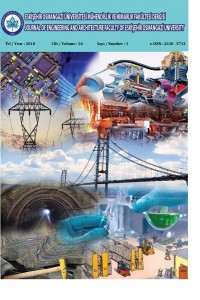Abstract
Türbidit
akıntısı bir çeşit yoğunluk akıntısıdır ve yaygın olarak kıta yamacı boyunca
oluşur. Çalışmanın amacını kıta yamacı boyunca doğal olarak gerçekleşen
sediment yüklü yoğunluk akıntılarının deneysel olarak gerçekleştirilmesi
oluşturmaktadır. Deney düzeneği kıta yamacına benzer şekilde tasarlanmış ve 10
mm kalınlığında cam malzemeden yapılmıştır. Deney düzeneğinin üst kısmında
ayrılan kısma tuzla yoğunluğu artırılmış ve içine boya maddesi konulan su
konulmuştur. Diğer bölüme ise normal çeşme suyu doldurulmuştur. Yoğunluğu fazla
sıvıyı diğer bölümden ayıran ara bölme kaldırılınca, yoğunluğu fazla olan
boyalı su diğer normal suyun içinde
aşağıya doğru akıntı türbülansı ile hareket etmektedir. Yoğunluğu fazla olan
sıvı boya maddesi içerdiği için, yoğunluk farkından dolayı oluşan hareket
rahatlıkla gözlenebilmektedir. Sıvılar arasındaki yoğunluk farkı arttıkça,
türbidit akıntısının hızı artmaktadır. Türbidit
akıntısı baş, gövde ve kuyruk kısımlarından oluşur.
References
- [1] S.Jr. Boggs, “Principles of Sedimentology and Stratigraphy”, New York, USA, Macmillan Publihing Company, 1987.
- [2] M. Görmüş, “Sedimantoloji ve Stratigrafi Temel İlkeleri”, Ankara Üniversitesi Yayınları cilt 415, Yayın No: 13, Ankara, Türkiye, 2014.
- [3] A.H. Bouma, “Recent and ancient turbidites and contourites”, Gulf Coast Association of Geological Societies Transactions, volume 22, pp. 205-221, 1972.
- [4] M.E. Tucker, “Sedimentary Petrology: An Introduction to the Origin of Sedimentary Rocks”, Oxford, UK. Blackwell Science, 1991. [5] F. Picha, A.R. Niem, “Distribution and extent of beds in flysch deposits, Ouachita Mountains, Arkansas and Oklahoma”, Journal of Sedimentary Research, volume 44, pp. 328-335, 1974.
- [6] D.A.V. Stow, G. Shanmugam, “Sequence of structures in fine-grained turbidites: Comparison of recent deep-sea and ancient flysch sediments”, Sedimentary Geology, volume 25, pp. 23-42, 1980.
- [7] P. Plink-Björklund, R.J. Steel, “Initiation of turbidity currents: outcrop evidence for Eocene hyperpycnal flow turbidites”, Sedimentary Geology, volume 165, pp. 29–52, 2004.
- [8] E. Mutti, D. Bernoulli, F.R. Lucci, R. Tinterri, “Turbidites and turbidity currents from Alpine ‘flysch’ to the exploration of continental margins”, Sedimentology, volume 56, pp. 267–318, 2009.
- [9] B.C. Kneller, S.J. Bennett, W.D. McCaffrey, “Velocity structure, turbulence andfluidstresses in experimental gravity currents”, Journal of Geophysical Research, volume 104, pp. 5381-5391, 1999. [10] R. Manica, “Sediment gravity flows: study based on experimental simulations”, in: H.E. Schulz, A.L.A. Simões, R.J. Lobosco, (Eds.), Hydrodynamics-Natural Water Bodies: Rijeka, Croatia, InTech, pp. 263–286, doi:10.5772/28794, 2012. [11] https://www.slideshare.net/hzharraz/sedimentary-ore-deposit-environments. Erişim tarihi: 1 Eylül 2017
- [12] https://www.google.com.tr/search?q=turbidity+currents&dcr=0&source=lnms&tbm =isch&sa=X&ved=0ahUKEwjKqJvL86vWAhUjIpoKHabmDxYQ_AUICigB&biw=1366&bih=662#imgrc=RIokfW1mcQh9mM: Erişim tarihi: 1 Eylül 2017. [13] H.G. Reading, “Sedimentary Environments and Facies”, 2nd ed. Oxford, UK, Blackwell Scientific Publications, 1986.
- [14] H.E. Reineck, I.B. Singh, “Depositional Sedimentary Environments”, Berlin, Germany Springer Verlag, 1980.
Details
| Primary Language | Turkish |
|---|---|
| Subjects | Geological Sciences and Engineering (Other) |
| Journal Section | Research Articles |
| Authors | |
| Publication Date | January 31, 2018 |
| Acceptance Date | December 20, 2017 |
| Published in Issue | Year 2018 Volume: 26 Issue: 1 |

